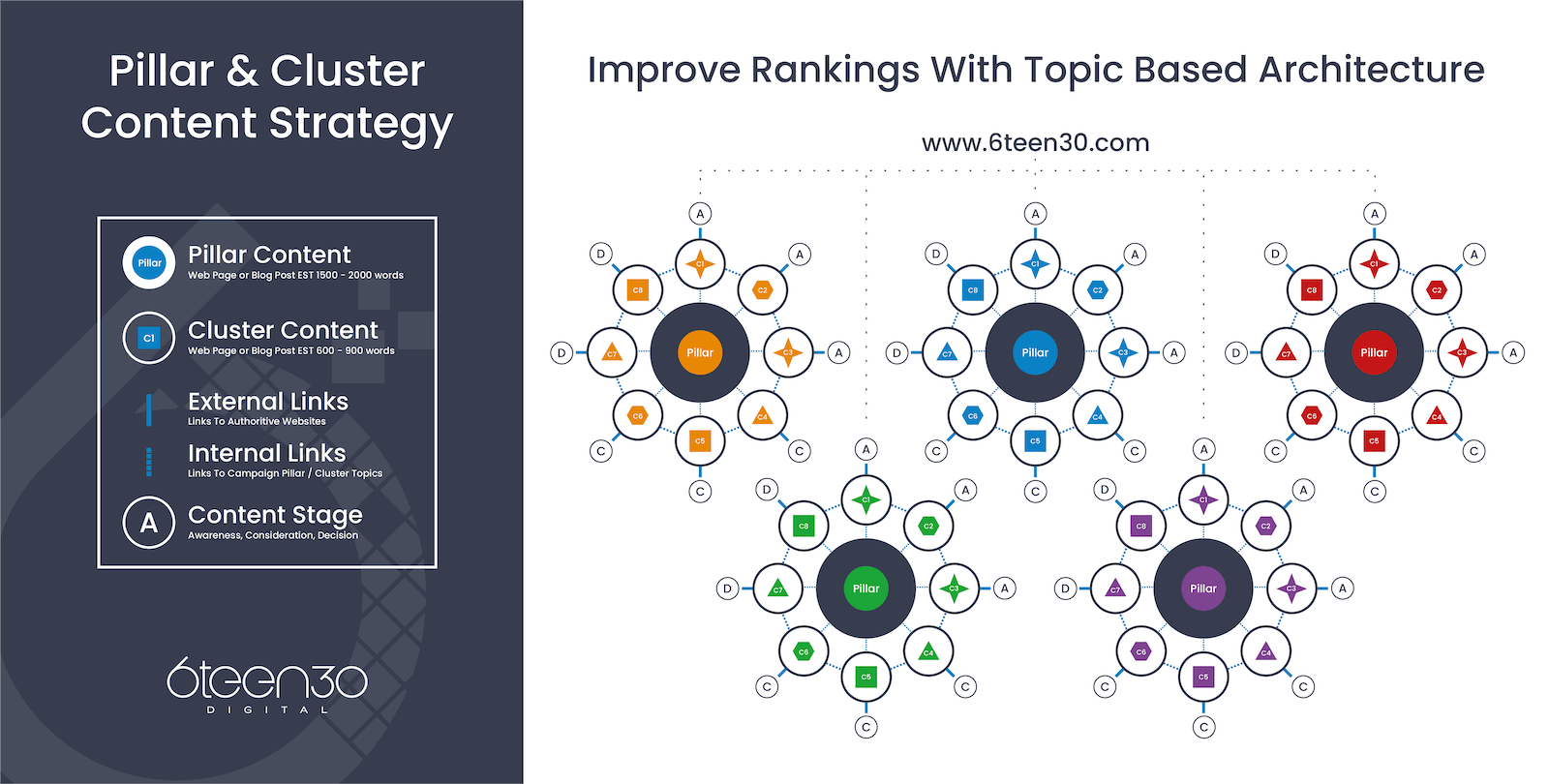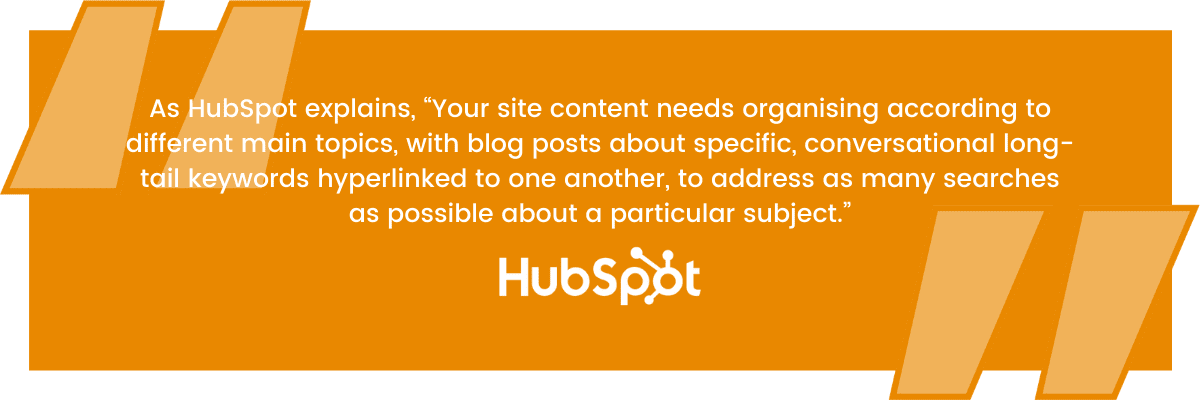
How To Improve Organic Search Results Using an Inbound Pillar Cluster Content Strategy versus Standard Content Production
SEO is undeniably a complicated beast to tame. There are over 200 known ranking factors – and likely plenty more that we don’t even know that exist.
Google plays its cards close to its chest when it comes to divulging how its ranking algorithms work.
As a small business owner, this can be nothing short of incredibly frustrating; it’s all too easy to sink lots of money into search engine optimisation only to find that your rankings haven’t budged or even worse, have declined.
Of course, you’re too busy running your business to spend the time needed to learn how SEO works to deliver on your digital marketing strategy.

Hiring in an expert full time can be expensive, with the average UK salary for an SEO professional in-house £42,500.
A cheaper hire, as you may have learnt to your expense, often won’t have the know-how or expertise to deliver the results you need.
One thing we do know is that content is king when it comes to SEO.
And that’s good news because it means we have the key to a fundamental question; how to improve organic search results which aren’t quite up to par?
The Old Way
Content has always been essential for SEO success.
For a long time, just creating as much content around a keyword as possible was a tried and tested route to the top of the search results pages.
Old school strategies would see you create as many blogs as possible, as often as possible, which meant lots of thin content. Resulting in lots of content overlap and often, lots of low-value content which was created purely for Google and not to satisfy the original query of the search user.
Creating content in this way not only alienates the user, who ends up frustrated they’re not getting the information they need, it is also very messy.
It’s the digital equivalent of throwing all of your files in the drawer, instead of filing them. With no structure other than to create content around specific keywords, it is difficult, if not impossible, to classify and organise content.
What’s more, when you have lots of similar content, you’re going to reach a stage where you compete with yourself on Google for rankings.
That’s a total waste of resources and means that you may never see your site ranking well for all of the keywords that are important to you.
Another issue with this dated approach to content creation is that Google has evolved far beyond it.
The search engine employs a complex series of machine learning and AI algorithms to help it source the most relevant results for its users.
Since 2018, it has used an AI neural matching system to relate words to searches better, while the AI-powered RankBrain, which associates pages to concepts have been in use since 2016.
In 2019, Google rolled out the ‘most significant ever’ change to search in more than five decades in the form of BERT. A sophisticated natural language processing tool which gives Google’s computers almost human-like understanding of language, which means search results are more refined for context and nuance.
These changes reflect the ever more complex and non-linear buyer journey, which may involve technologies such as voice search, and search queries that are question rather than keyword based.
The magnitude of this shift also means that your content strategy and the way you produce blog content must again undergo a massive transition to give the complex new algorithms the information and good quality indicators needed to rank well.
The New Way
As mentioned in our inbound marketing framework for high growth service businesses.

Google handles over 3.5 billion searches each day.
There are approximately 5.7 billion pages indexed, and many more added each day.
The old way of creating content is simply too messy to be efficient. As Google has gotten more sophisticated, it has focused on finding ways to sniff out the best quality, more relevant content as part of its mission to give users “…useful and relevant results in a fraction of a second.”
So here’s the modern answer to that age-old question of how to improve organic search results, keeping in mind all we know about Google’s shift to focus on search intent and its desire to return useful, informative content to its users:
To address this, we recommend you use the pillar and cluster model.
First identified by HubSpot, the world’s leading marketing automation software, the pillar and cluster model sees a pillar page sitting at the centre of content creation.
This pillar is a single page which covers a broad topic in-depth, then individual cluster pages which go into more detail about each subtopic are then created.
The cluster pages then link back to the pillar.

How EXACTLY Does Pillar And Cluster Content Help Your SEO?
1. Authority:
Choosing a core topic, and then expanding upon it with dedicated clusters, has been shown to improve organic search positions.
This type of content structure ensures a high level of detail, creating an authoritative resource which provides plenty of food for the Google algorithm and lots of useful, value-add content for the consumer.
According to HubSpot, this approach to content saw it grow monthly search engine visits and improve the rankings of hundreds of keywords.
Download Your Copy Of Bound To Grow: The High Growth Companies To Scaling Revenues Using Inbound Marketing
2. Search habits:
Over half of all search engine queries (64%) contain an average of four words.
Research by Ahrefs shows that long-tail searches, such as “how to lose weight” have lots more search volume than the shorter “lose weight”.
More conversational search queries are becoming the norm – this could be due to the popularity of new technologies such as voice search and smart speakers. Still, it’s also due to search users being more specific about the kind of information they want returning from Google and other search engines.
While the older blog content model resulted in disorganised posts, hard to find information and content which competed against itself for rankings, the pillar and cluster model taps into conversational search.

3. Highly focused keywords:
The pillar and cluster model allows you to cover a broad topic in-depth, and this means that your content naturally contains highly focused keywords and search phrases.
As those phrases tend to have less search volume than short-tail keywords, the easier it should be to rank.
Search Engine Journal columnist Manish Dudharejia explains this further, noting,
“Pillar content is generally focused around a broad keyword with a high search volume, whereas topic clusters are focused on more specific keywords with smaller (attainable) search volumes. You should aim to create these pieces of content around granular subtopics with low search volume keywords. When I talk about using topic clusters as a long-term strategy to gain search rankings for broad, overarching keywords, I like to frame it like playing with dominoes. Each domino represents the search volume of a certain keyword.”
“The first domino is the smallest. Once you give it a nudge (meaning the content starts to gain search rankings), it should ideally knock down a slightly bigger domino, which will then knock down a bigger one, then a bigger one, and so on and so forth.”









%20-%20Teal.png?width=500&height=130&name=Force%20%26%20Friction%20-%20Branding%20-%20Logo%20(White)%20-%20Teal.png)